|
|
|


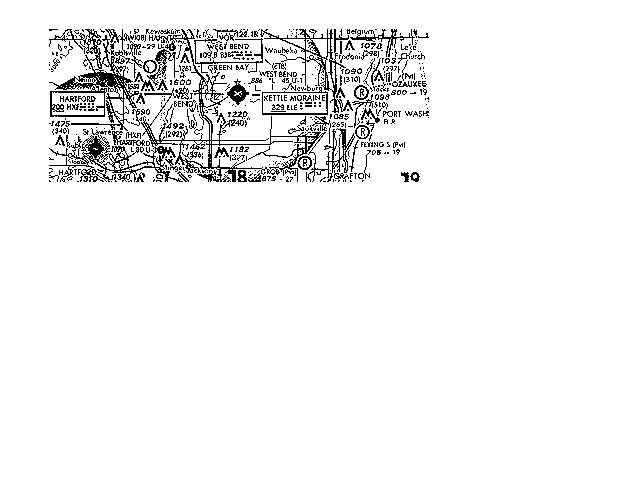
Vol. 1 No. 2 - November/December 1996
 Upcoming Chapter Meetings
Upcoming Chapter Meetings


 NO CHAPTER MEETING IN DECEMBER
NO CHAPTER MEETING IN DECEMBER




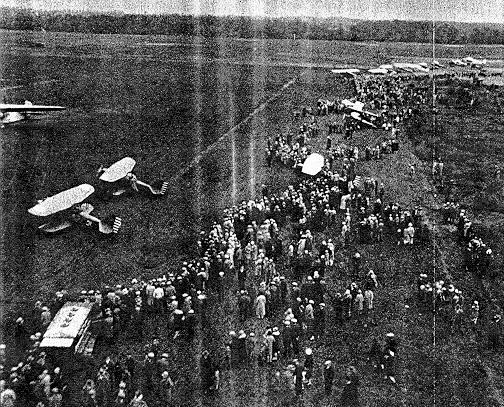 Airport Dedication Celebration - May 25, 1930 |
In 1845, the Wisconsin Territorial Legislature authorized the building of a road between Milwaukee and Fond du Lac. The three Commissioners appointed to lay out the road and seek the half way point were Byron Kilbourn, James Kneeland and E.B. Wolcott. The men traveled on horseback, and as they arrived at the westward bend of the Milwaukee River, they decided it would be an ideal spot for a village. This village was later incorporated into the city of West Bend.
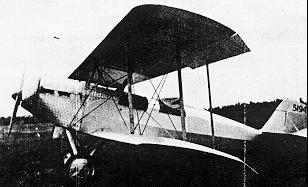 One of the first planes at West Bend Airport |
At the encouragement of local businessmen yearning for a local airport, in 1929 the city bought 100 acres of land two miles east of town. A sum of $15,000 was paid to the original investors, B.C. Ziegler, Dr. Wm. Urkart and Frank Groom. West Bend thus became the first city of its size in Wisconsin to own land for an airport.
By November, 1929, a rotating beacon was installed, boundary lines were laid out, drain tile was installed, and the airport was leased as a landing strip to the Fox River Valley Airmail Service. On the 25th of May, 1930, a big celebration was held when the airport was dedicated. Airplane stunts and other events entertained the large crowd. The first plane from out of town to land at the airport was a Ryan cabin monoplane, which brought Governor Kohler to pick up the American Legion and Legion Auxiliary membership cards as a stunt to help the new airport.
After a metal hangar was built and celebrated with a 40 plane parade, lessons began for local people, some of whom eventually served the United States Air Force in both World War II and the Korean War. Miss Lillian Puestow was the first young lady to take flying lessons. By 1942 there was a long 3,000 foot airstrip as well as a shorter one, and the property was leased to Al Haen and Earl Stier.
By the 1970's local business firms used the airport regularly and Lear jets were a common sight. Helicopters and the newest sport, gliding, also used the airport, and land purchases proceeded for future expansion.
Source: "The Spirit of West Bend", by Dorothy E. Williams
(This first installment of "A Moment in History" has been
showcased as our feature article. Future issues will have
shorter installments of historical interest as the closing
article. - Editor)


 Mailbag
MailbagKyle Howard writes:
Wow! I am thrilled about the amount of food sales!! That's great. And I gotta say, the hot dog I had was great (what can ya say about a hot dog? A lot when it is cooked the way you like it!). A very important job done by unsung heroes!! Thanks.
Young Eagle Rides: Having only one seat I had not planned to fly. But, Paul Lupton was giving rides in his C-150, so between the two of us we were able to help. We set up a nice pattern over town and it went real smooth. Don Brinkley did a great job running it (as he usually does).
The Civil Air Patrol were great. I guess I am not aware of how much the general public lacks awareness, but they actually had to ask people to step back as we were wanting to start our engines! It is always good to have extra eyes - and people who know how to conduct ramp operations. Lt. Mike Wimmer and his cadets are very experienced in ramp operations as he takes them to all fly-ins within their driving distance and works them. I hope they were able to get recruits from it.
Too bad for the weather. It looked like a great turnout. And not having rain for so long, it was a shame it couldn't hold out for another 2-3 hours!
Dan Staehler adds:
In regards to the serving of the food - Might it be a little more organized to have a cashier at one end of the table to handle all the money, and the rest of us as runners?
Chapter Library
From Gary Lackie:
Do you think a chapter library of aviation books, videos, etc., assembled at West Bend Air is doable? Or at least a list of members' material available for loan? We all have something gathering dust, don't we?
(This is being discussed by the board. With all of our members,
we should be able to put together a collection of all issues of the
primary aviation magazines going back many years. Books and videos
would be great. - Editor)



Thanks to all the volunteers who helped make our first open house
a great success. One thing we learned is that we could use even
more volunteers to help cook and sell food, and to assist with the
Young Eagle flights. We all had a great time, so if you weren't
able to help out this time, think about joining the fun next time.
Russ Kaye is the chairman of our newly-formed Newsletter Publishing
Team. Thanks to Russ and all the team members for copying and
distributing each issue. If you need a copy of a back issue,
contact Russ at
rkaye@execpc.com or
414-284-3154. Thanks also to our volunteer proofreaders.
See the "Officers, Teams, Committees" section in this issue.
About 20% of our members are on the Internet. Advantages include
online weather, aviation software you can download for free,
and access to our chapter home page
(http://www.execpc.com/~sroensch/eaa), which provides links
to EAA headquarters and many other interesting sites.
Online members have been regularly exchanging email,
which provides virtually instantaneous communication.
In addition to notes, we can send each other computer files.
For example, some of the articles in this issue were submitted
electronically. And, of course, you have access to all the
non-aviation information on the web. If you've been thinking
about "getting online", this may be the time. Feel free to give
me a call at 375-2228 if you'd like help getting pointed in the
right direction. There are several Internet Service Providers
(ISP's) in the area, ready to hook you up. The cost is about
$12 to $18 a month. Don't forget to try out the free Internet
access provided by the West Bend Library.
We need to decide as a group if we want to name the newsletter, and if so, what the name should be.
Paul Lupton (cfiphd@aol.com)
has suggested
Cloud Chatter, Cloud Cruisin', Tailwinds, Kettle Chatter,
Chapter Chatter, Hangar Flying, Runway Rambles, Kettle Flyer,
Crosstalk, Plane-Talk, Prop-Talk, The Home Field,
The Aero-Gram or Turbo-Chatter. Ed Emanuel
submitted High Performance.


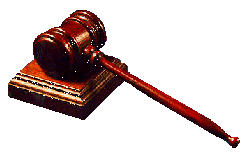
Thanks to one and all who helped, participated or worked
behind the scenes to make it all happen.
One of the enjoyments (and responsibilities) of seeing our
chapter get off the ground is the efforts of many people to make
that happen. Our chapter has already
seen several successes:
On behalf of the chapter I'd like to recognize some people's
efforts in making this happen. Don Brinkley, our Young Eagles
Coordinator, is off to a great start. Steve Roensch, Glen
Brandt and their committees did all the preparation and cooking
at our open house. Many other chapter members, spouses, friends
and Civil Air Patrol members flew Young Eagles
or helped with the mass of people on the ground.
Steve Roensch, Russ Kaye and our publishing team have done a
stellar job in getting the newsletter off to a great start! Over 100 Young Eagles flown
Over 100 Young Eagles flown
 Over 70 members joined
Over 70 members joined
 A vital and financially successful part in
our airport's open house
A vital and financially successful part in
our airport's open house
 A tremendous newsletter/presence on the Internet
A tremendous newsletter/presence on the Internet
 A plan for next year!
A plan for next year!



This month's topic is antennas for composite aircraft.
But before I get started, I want to encourage other builders
to contribute to this column. If you have some knowledge to
share, give me a call (375-4320) and let's talk about it.
There are a number of ways to contribute. If you want
to do it all, you can write a column and submit it to Steve
Roensch via e-mail. At the other end of the spectrum, I can
talk with you and I will write the column and submit it to Steve.
The maximum useful distance between a transmitter and receiver
is determined by a number of factors, such as, the power of the
transmitter, the construction of the transmitter, the construction
of the receiver, the receiver's antenna, the transmitter's antenna,
atmospheric conditions, cables, connectors, etc. While most of
these factors are beyond our control, in experimental aircraft we
have control over the antenna we use.
In metal airplanes, the airframe is often used as a ground plane
and forms part of the antenna. Conventional NAV and COM antennas
require a ground plane to efficiently transfer the transmitter's
signal to radio waves that propagate to the receiver or to
efficiently receive the propagated radio waves and transfer them
to the receiver.
In a composite aircraft, the airframe is non-conductive and
therefore does not provide the ground plane. One of the earliest
solutions to the problem of putting antennas on composite aircraft
came from Jim Weir of RST. He suggested that builders construct a
dipole antenna from copper foil tape and add three ferrite beads to
the coaxial cable to keep the reflected signal to a minimum. This
antenna is simple to build and the parts to build it cost about $5.00.
However there are several issues
with this type of antenna:
A folded dipole antenna, with a balun, overcomes the three
problems listed for the dipole antenna. While the folded
dipole is simple in principle, I chose to buy, rather than
make, the antennas for my Defiant. (The antennas can be
purchased from Advanced Aircraft Electronics Inc. of
Florissant, Missouri.) Since I had already built the simple
dipole antennas, I measured their performance before I
replaced them. Here are the results of my tests. Each
antenna was connected to a VSWR meter through 20 ft. of
RG-58A/U cable.
A perfect antenna/cable would have a VSWR of 1.0. A VSWR of
less than 2 is very good. What does all this mean? Several
pilots have reported that they have doubled the useful range
of their radios by replacing their dipole antennas with the
folded dipole antenna from Advanced Aircraft Electronics!
Antenna Performance as Indicated
by Voltage Standing Wave Ratio
Frequency
Dipole Antenna
Folded Dipole Antenna
105 MHz
3.0
1.0
113 MHz
2.9
1.2
120 MHz
1.7
1.3
128 MHz
1.2
1.3
135 MHz
1.7
1.4
143 MHz
2.4
1.2
150 MHz
2.0
1.1 

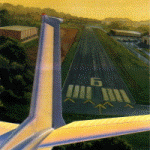
As of late there has been a great deal of discussion by the NTSB,
FAA, GADO and others as to the appropriate way to enter a traffic
pattern. Obviously this assumes that the pilot
is at least safety conscious
enough to attempt to fly an appropriate pattern. Many of our guests
don't and really make a mess out of the orderly flow of traffic.
Hats off to the West Bend pilots. Most of them do a pristine job of
communicating their intentions and flying a great pattern at the
prescribed altitudes. We have a wide variety of aircraft using the
airport and just as wide a variety of approach speeds. We have also
been blessed with four instrument approaches, two on 31, one on 24,
and one on 13. VFR pilots must listen for the key radio calls to know
when one of these approaches is in use. These are "GOREY inbound",
"FLAMS inbound", "procedure turn inbound", or "5 mile final for
runway xx".
A good pattern gives a good view from above of these approaches.
Remember that a faster aircraft usually means a larger pattern.
The local 152 usually uses about a half mile pattern except when
a student strays a bit. Local turbine aircraft run at about a mile,
with twins and high-performance singles somewhere in between.
With this mix in mind it is strongly recommended that pattern entries
be made at 1900 feet msl
and either (1) at a 45 degree angle to
downwind at the departure end of the active runway,
or (2) a crosswind entry over the departure numbers
of the active runway. Only these
two entries give the best visibility of other aircraft working the
pattern, departing the pattern, or entering the pattern. Remember
the slower or smaller you are the closer you should be to home to
avoid conflicts with other high speed aircraft.
Departing the pattern should be accomplished by maintaining 1600 feet
msl straight out of the airport area or by climbing on one of the legs
of the pattern to an altitude of 500 feet above pattern altitude and
then turning onto your heading. Remember to be alert for turbine
aircraft that may be operating in the range of a 2000 foot agl
pattern. The "right turn out" may seem a good idea but is not
recommended as it has you in a nose high attitude headed right into
extended crosswind traffic.
Please announce your intentions.
Aviate Navigate Communicate Communicate Communicate -
Fly Safely!
Addendum to Tip #1:
As discussed in the last newsletter,
local policy at West Bend airport recommends that all pilots
climb on take off to 1600' msl (700' agl) on runway heading.
Note how this ties in with Tip #2, by clearing the way for
others making a 45 degree or over the numbers crosswind entry.
In addition, climbing to 700' agl rather than 400' agl before turning
over the city reduces the noise footprint presented to those on the
ground by over 67%! Let's all be good neighbors.
Did you know?!!!

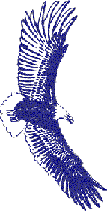
Chapter 1158's first participation in the Young Eagles Program took place on September 8th, 1996 as part of the open house at the airport. A total of 72 Young Eagles were flown, but we had to turn away 38 youngsters still waiting when the rain shut down our flying activities at 2:30 pm.
The following members participated: Kyle Howard flew her Varieze and 6 Young Eagles. Paul Lupton, in his Cessna 150, flew 3. Ken Seidl flew 18 in his Mooney. Allan Price flew 12, and Nora Price flew 9, in their Piper Arrow. Jim Retzlaff had 24 Young Eagles up in his Grumman Cheetah. Chapter members who helped out on the ground were Marsha Seidl and Dale Carlson. Also thanks to the Civil Air Patrol for their help in crowd control.
September Chapter Meeting
Steve Buss, Executive Director of the Young Eagles Program at
Oshkosh, was our guest speaker for our regular chapter meeting.
He explained what the program was and where we were today.
The goal of the program is to fly one million
young people by 2003,
and there have been over 236,000 flown so far. Many questions
were asked. Following the presentation, Don Brinkley presented
Certificates of Appreciation to those who participated in the
September 8th Young Eagle flights. One of the ways of recognizing
pilot participation is through an awards program.
One of these awards is a pair of wings with "10 for 96" to indicate
that the pilot has flown 10 or more Young Eagles in 1996. Steve Buss
awarded wings to four of our chapter members:
Jim Retzlaff, Nora Price, Allan Price and
Ken Seidl. Chapters also can receive awards by setting
goals for flying Young Eagles and then meeting or exceeding these
goals. Our chapter has not submitted our goals as of yet, but we
do have 72 flights to our credit.



September 4, 1996 Meeting
Present: Howard Kaney, Allan Price, Glen Brandt,
Don Brinkley, Ron Champeny, Steve Roensch
The first item on the agenda for this board meeting was a general
discussion of chapter objectives and programming ideas. We
attempted to establish goals and guidelines for the chapter
in general and some of our committees in particular. It became
apparent that this will be an ongoing effort, not capable of
being solved in one or two sessions.
Al Price reported on the status of plans made by the Friends of
the Airport for the Open House at the West Bend Municipal Airport
on September 8.
Steve Roensch and Glen Brandt reported on our first
fund-raiser: preparations made by the Kettle Moraine
chapter to sell food to the public at the Open House.
It was agreed that charter membership status in our EAA
Kettle Moraine chapter will be closed at the end of September.
Glen Brandt, treasurer, reported on the progress of paperwork
to establish our tax exempt status and nonprofit status.


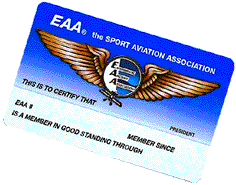
Welcome aboard!


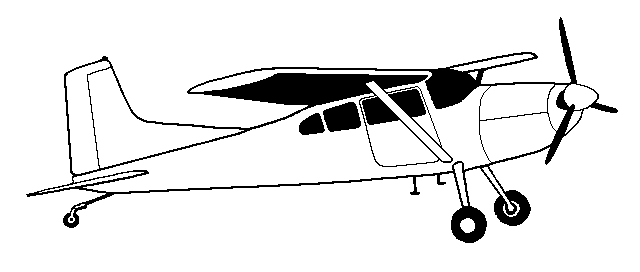

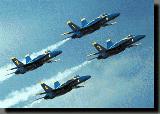
Chapter Meeting: 3rd Wednesday of each month, 7:00 pm
(Bring a chair) West Bend Airport, Hwy 33 East, West Bend, Wisconsin
Board Meeting: 1st Wednesday of each month, 7:00 pm
West Bend Airport, Hwy 33 East, West Bend, Wisconsin

(Officers July 1996 - December 1997)
Area Code 414
President Howard Kaney 334-9451 hkaney@execpc.com
Vice President Richard Feldschneider II 414-677-3416
Secretary Allan Price 334-1278
Treasurer Glen Brandt 268-1648
Board Members Don Brinkley 335-6519
Allen Bruggink 335-6459
Ron Champeny 334-4309
Steve Roensch 375-2228 sroensch@execpc.com
Young Eagles Coordinator Don Brinkley 335-6519
Fly-Out Chairman Jim Retzlaff 338-3728
Historian Ernestine Lynfoot 377-9163
Internet Webmaster Steve Roensch 375-2228 sroensch@execpc.com
Home Page http://www.execpc.com/~sroensch/eaa
Newsletter:
Editor Steve Roensch 375-2228 sroensch@execpc.com
Reporters Glen Brandt 268-1648
Paul Lupton 338-1826 cfiphd@aol.com
Ernestine Lynfoot 377-9163
Allan Price 334-1278
Jim Rodrian 377-4320 jrodrian@elsyn.com
Greg Schmidt 284-0918 magrew@execpc.com
Proofreaders Kris Hinterberg 334-1809 kris@hnet.net
Kyle Howard 334-2624 kyle@hnet.net
Gary Lackie 375-0859 glackie@execpc.com
Publishing Team:
Chairman Russ Kaye 284-3154 rkaye@execpc.com
Don Brinkley 335-6519
Bill Groeneveld 334-9436
Gary Lackie 375-0859 glackie@execpc.com
Paul Lupton 338-1826 cfiphd@aol.com
Marv Powell 791-4737
Rick Woyak 338-3801
Sandra Zorn 626-8764
Membership Committee:
Chairman Dan Staehler 338-1351 staehler@pmihwy.com
Welcoming Chairman Allan Price 334-1278
Recognition Committee:
Chairman Allen Bruggink 335-6459
Don Brinkley 335-6519
Program Committee:
Chairman Ron Champeny 334-4309
Allen Bruggink 335-6459
Terry Ganzel 338-1574
Bill Groeneveld 334-9436
Howard Kaney 334-9451 hkaney@execpc.com


Win fame and fortune!
Well, at least some fame, and a great jacket...
This is the official call for entries for our chapter patch contest. The winner will receive an official EAA jacket in their size. Put your design on an 8½x11 sheet of paper, and get it to Allen Bruggink (335-6459) no later than our November 20th chapter meeting. We will reduce it to the approximately 3 inch diameter patch size. All patch designs should include "EAA Chapter #1158" and "West Bend, Wisconsin" or "West Bend, WI". Remember, the patch size is only about 3 inches, so don't get too carried away with detail.
DUATS Cirrus Software
The latest GTE DUATS Cirrus software is now available free. Per MentorPlus:
"Cirrus allows you to request most DUATS functions off-line using an intuitive graphic interface. With its extensive database of airports and VORs, Cirrus lets you to plan your flight graphically by pointing and clicking on a map. Next, you decide what types of weather information or flight planning services you need from the free DUATS on-line service. You may download graphic weather maps, so you can see at-a-glance what types of weather you will be flying through. Then all you do is click on the DIAL button and Cirrus downloads the requested information. You can immediately review the information off-line or look at it later."
See our chapter web page (http://www.execpc.com/~sroensch/eaa)
aviation links section to download your free copy, or call Steve
Roensch at 414-375-2228.


This and all Kettle Moraine EAA Chapter #1158 newsletters are
provided for your enjoyment only. No claim is made and no
liability is assumed, expressed or implied as to the accuracy
or safety implications of any material presented. Viewpoints
of the writers are not necessarily those of this or any EAA
Chapter or of the Experimental Aircraft Association (EAA).
Use of any of the material presented, whether by applying,
copying or quoting, is done solely at the risk of the user.
|
Upcoming Chapter Meetings
Wed, 10/16, 7 pm Bring a chair! |